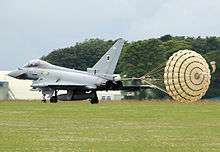Drogue parachute
A drogue parachute is a parachute designed for deployment from a rapidly-moving object. It can be used for various purposes, such as to decrease speed, to provide control and stability, or as a pilot parachute to deploy a larger parachute. Vehicles that have used drogue parachutes include multi-stage parachutes, aircraft, and spacecraft recovery systems.
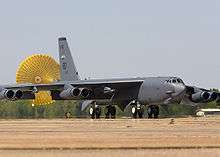
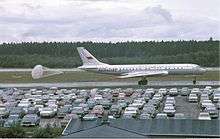
The drogue parachute was invented by the Russian professor and parachute specialist Gleb Kotelnikov in 1912, who also invented the knapsack parachute. The Soviet Union introduced its first aircraft fitted with drogue parachutes during the mid 1930s; use of the technology expanded during and after the Second World War. A large number of jet-powered aircraft have been furnished with drogue parachutes, including the Boeing B-52 Stratofortress strategic bomber and the Eurofighter Typhoon multirole aircraft; they were also commonly used within manned space vehicle recovery programmes, including Project Mercury and Project Gemini. The drogue parachute has also been extensively used upon ejection seats as a means of stabilisation and deceleration.
History
The drogue parachute was first used during 1912 in a ground-based parachute test in the absence of airplanes, by Russian inventor Gleb Kotelnikov, who had patented a one of early canister-packed knapsack parachute a few months before this test. On a road near Tsarskoye Selo (now part of St. Petersburg), Kotelnikov successfully demonstrated the braking effects of such a parachute by accelerating a Russo-Balt automobile to its top speed and then opening a parachute attached to the back seat.[1]
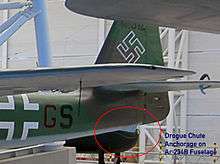
During 1937, the Soviet Union decided to adopt the drogue parachute for the first time upon a limited number of their aircraft, specifically those assigned to operate within the Arctic to provide logistical support for the famous polar expeditions of the era, such as the first drifting ice stations North Pole-1, which was launched that same year. The drogue parachute was credited with enabling airplanes to land safely on smaller ice-floes that were otherwise unfeasible landing sites.[1]
One of the earliest production-standard military aircraft to use a drogue parachute to slow down and shorten its landings was the Arado Ar 234, a jet-powered reconnaissance-bomber used by the Luftwaffe. Both the trolley-and-skid undercarriage series of eight prototypes for the never-produced Ar 234A series — one on the aircraft, and a separate system on the aft surface of the trolley's main axle — and the tricycle undercarriage-equipped Ar 234B production series were fitted with a drogue parachute deployment capability in the extreme rear ventral fuselage.
During the space race between the United States and the Soviet Union, drogue parachutes were adopted on numerous spacecraft. Several human space programmes managed by NASA, including Project Mercury and Project Gemini, employed drogue parachutes in their vehicle recovery systems.[2][3][4] Numerous other space-oriented organisations, such as SpaceX, have similarly adopted drogue chutes as part of their recovery systems.[5]
Design and operational characteristics
In comparison to a conventional parachute, the drogue parachute is more elongated and has a far smaller area; as a result, it provides far less drag. While a drogue parachute is incapable of slowing down an object as much as a conventional parachute, it is capable of being deployed at speeds at which conventional parachutes would be torn apart.[6]
As a direct consequence of its simpler design, the drogue parachute can be more easily deployed. Where a conventional parachute could get caught in itself while unfolding or fail to inflate properly (thus not slowing the falling object as much as it should), the drogue parachute will inflate more easily and more reliably to generate the expected amount of drag.
Use
Parachuting
Drogue parachutes are sometimes used to deploy a main or reserve parachute by using the drag generated by the drogue to pull the main parachute out of its container. Such a drogue is referred to as a pilot chute when used in a single user (sports) parachute system. The pilot chute is only used to deploy the main or reserve parachute; it is not used for slowing down or for stability. Tandem systems are different; a drogue is so deployed shortly after exiting the aircraft as to reduce the terminal velocity of the pair of tandem jumpers. It is later used to deploy the main parachute as on sports systems.[7][8]
Numerous innovations and improvements have been made to drogue parachutes intended for this purpose; examples include a patent for an anti-spinning feature granted during 1972,[9] and improved force distribution granted in 2011.[10]
Deceleration
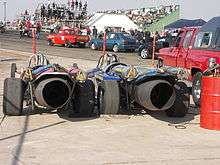
When used to shorten an aircraft's landing, a drogue chute is called a drag parachute or braking parachute. They are particularly effective when used by aircraft that are landing on wet or icy runways and for high speed emergency landing.[11]
Braking parachutes are also employed to slow down cars during drag racing; the National Hot Rod Association (NHRA) requires their installation on all vehicles able to attain speeds of 150 miles per hour or greater. They have also been installed on multiple experimental vehicles intended to conduct land speed record attempts.[12][13]
Stability
Drogue parachutes may also be used to help stabilise direction of an object in flight, such as a thrown RKG-3 anti-tank grenade. It is often used to gain control of very fast descents, including those of spacecraft during atmospheric reentry, examples include the Boeing X-37 spaceplane.[14][15] It has been used for similar purposes when applied to several nuclear bombs, such as the B61 and B83.
Drogue parachutes have found use on ejection seats to both stabilise and to slow down almost immediately following deployment, examples include the ACES II personal escape system.[16] Similarly, a number of escape capsules, used on both supersonic aircraft and spacecraft, have employed drogue parachutes both for stability and braking, allowing either a main chute to be deployed or for the pilot to exit the capsule and use a personal parachute. Some high altitude rockets have used drogue chutes as part of a dual-deployment system, subsequently deploying a main parachute to control and slow their descent.[17][18]
See also
- Air brake (aircraft)
- Drogue
- Sea anchor
References
- "Parachuting at the site Divo: The Russian Book of records and achievements" (in Russian). bibliotekar.ru.
- "Parachute, Drogue, Mercury". Smithsonian Institution, National Air and Space Museum. Retrieved 17 June 2020.
- "Parachute, Drogue, Gemini". Smithsonian Institution, National Air and Space Museum. Retrieved 17 June 2020.
- Anita Sengupta, Ricardo Machin, Gary Bourland, Ellen Longmire, Mitch Ryan, Erik Haugen, Edward White, James Ross, Joes Laguna, Robert Sinclair, Elsa Hennings, and Daniel Bissell (2012). "Performance of a conical ribbon drogue parachute in the wake of a subscale Orion command module". IEEE Xplore.CS1 maint: uses authors parameter (link)
- Messier, Doug (12 April 2018). "More Details on SpaceX's Fairing & Drogue Parachute Recovery Efforts". parabolicarc.com.
- "Relive Apollo 11 Glossary: Abbreviations and Acronyms". NASA. Retrieved 17 June 2020.
- Brain, Marshall. "How Skydiving Works". adventure.howstuffworks.com. Retrieved 17 June 2020.
- "What are Drogues in Skydiving?". skydivecal.com. 9 December 2018.
- "Aerial flare with drogue parachute". Google. 1972.
- "Skydiving equipment to distribute the tension forces of a drogue parachute". Google. 2011.
- "Deceleration Parachutes". Miles Manufacturing. Retrieved 17 June 2020.
- "North American Eagle Project: Deceleration – High Speed Parachute Systems". Archived from the original on 9 October 2010.
- "Engineering Special Report: How to slow a supersonic car with a parachute". bloodhoundlsr.com. 27 August 2019.
- Stephen A. Whitmore, Brent R. Cobleigh, Steven R. Jacobson, Steven C. Jensen, and Elsa J. Hennings. "Development and Testing of a Drogue Parachute System for X-37 ALTV/B-52H Separation" (PDF). NASA.CS1 maint: uses authors parameter (link)
- Stephen A. Whitmore and Elsa J. Hennings (November 2007). "Design of a Passively Reefed, Collapsible Drogue Parachute System". Journal of Aircraft.CS1 maint: uses authors parameter (link)
- "ACES II Ejection Seat Stabilizing Drogue Parachute". Life Support International. Retrieved 17 June 2020.
- "Drogue Parachutes". apogeerockets.com. Retrieved 17 June 2020.
- House, Marie (24 May 2019). "The Design and Development of an Electromechanical Drogue Parachute Line Release Mechanism for Level 3 High-Power Amateur Rockets". pdxscholar.library.pdx.edu.
